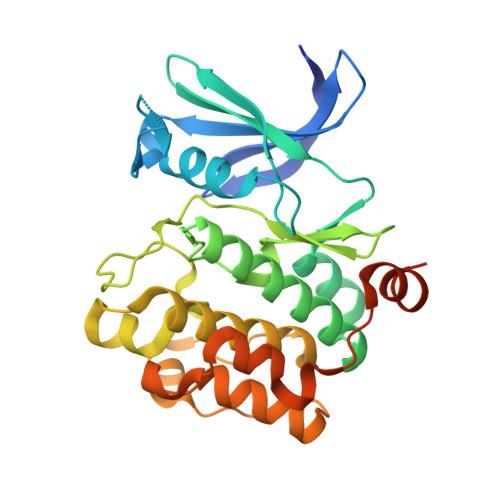A novel pim-1 kinase inhibitor targeting residues that bind the substrate Peptide.
Tsuganezawa, K., Watanabe, H., Parker, L., Yuki, H., Taruya, S., Nakagawa, Y., Kamei, D., Mori, M., Ogawa, N., Tomabechi, Y., Handa, N., Honma, T., Yokoyama, S., Kojima, H., Okabe, T., Nagano, T., Tanaka, A.(2012) J Mol Biol 417: 240-252
- PubMed: 22306408
- DOI: https://doi.org/10.1016/j.jmb.2012.01.036
- Primary Citation of Related Structures:
3UIX - PubMed Abstract:
A new screening method using fluorescent correlation spectroscopy was developed to select kinase inhibitors that competitively inhibit the binding of a fluorescently labeled substrate peptide. Using the method, among approximately 700 candidate compounds selected by virtual screening, we identified a novel Pim-1 kinase inhibitor targeting its peptide binding residues. X-ray crystal analysis of the complex structure of Pim-1 with the inhibitor indicated that the inhibitor actually binds to the ATP-binding site and also forms direct interactions with residues (Asp128 and Glu171) that bind the substrate peptide. These interactions, which cause small side-chain movements, seem to affect the binding ability of the fluorescently labeled substrate. The compound inhibited Pim-1 kinase in vitro, with an IC(50) value of 150 nM. Treatment of cultured leukemia cells with the compound reduced the amount of p21 and increased the amount of p27, due to Pim-1 inhibition, and then triggered apoptosis after cell-cycle arrest at the G(1)/S phase. This screening method may be widely applicable for the identification of various new Pim-1 kinase inhibitors targeting the residues that bind the substrate peptide.
Organizational Affiliation:
RIKEN Systems and Structural Biology Center, 1-7-22 Suehiro-cho, Tsurumi, Yokohama 230-0045, Japan.



















